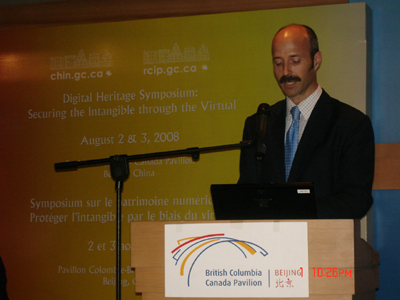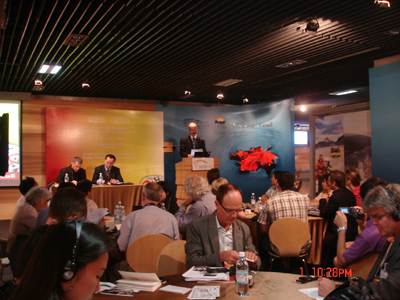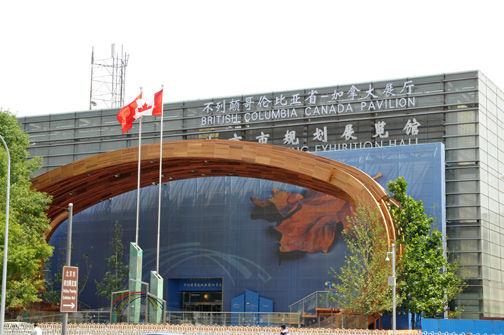Speaker:DU Fachun

Canada-China Digital Heritage Symposium BC Canada Pavilion

Patrice Cousineau addressed openning remarks on behalf the Canadian Embassy.jpg

Canada-China Digital Heritage Symposium

Canada-China Digital Heritage Symposium: Securing the Intangible Through the Virtua
A special conference entitled “Canada-China Digital Heritage Symposium: Securing the Intangible Through the Virtual,” which co-organized by the Department of Canadian Heritage, Canadian Embassy in Beijing, Canadian Museum of Civilization, the University of Ottawa on August 2 and 3, 2008, at the BC-Canada Pavilion in the Beijing Planning Exhibition Hall in Beijing, China. This symposium addressed recent developments in the field of cultural heritage preservation and dissemination, focused on how heritage professionals and academics, in Canada and China, are using information and communication technology to preserve, to promote and to make accessible intangible cultural heritage.
This event was opened by officials from both countries including Mr. Patrice Cousineau, Counsellor and Head of Public Affairs at Canadian Embassy, Mr. QU Shengrui, Director General, Division of Intangible Cultural Heritage, State Ministry of Culture China. Two keynote speeches by Ms. Gabrielle Blais, Director General, Department of Canadian Heritage “Mobilizing Innovation at Canada’s Heritage Institutions”, and Dr. Marie Françoise Guédon, Director of Interculture Centre, University of Ottawa “What is Intangible Culture?”. The Moderators of this smposium are Dr. LI Qiang, University of Ottawa, and Dr. Lorne Holyoak, Department of Canadian Heritage. Mr. Mark Rowswell (Dashan) ,the Goodwill Ambassador for the B.C.-Canada Pavilion welcomed Chinese participants.
On behalf of the Embassy of Canada in China, in his opening remarks, Mr. Cousineau pointed out that this Canada-China Digital Heritage Symposium exemplifies, in many ways, the ideals and goals that guided the Governments of Canada and British Columbia’s decision to establish this pavilion during this historic Olympic year in China’s capital city. The pavilion provides a venue for Canadian business and cultural promotion, a place where Chinese and Canadians can meet, interact and learn from each other. The Embassy has been involved from the beginning in the establishment of the Pavilion. We are also significantly involved in supporting Canada-China cultural exchanges through bilateral cultural instruments such as the Canada-China Cultural Agreement and the Canada-China Film Co-Production Agreement, pursuant to which many successful initiatives in have been undertaken over the last several years. One of the most successful one to date is the longstanding cooperation between the Canadian Museum of Civilisation and the National Museum of China, cooperation which saw the opening yesterday of a remarkable exhibition on Canadian First Nations masterworks at the Beijing Art Museum of Imperial City, following an equally successful exhibition of Chinese artefacts in Canada. Counsellor Cousineau cited a few examples of Canada-China exchange activities recently. The Royal Ontario Museum, in Toronto, has a number of ongoing curatorial research projects taking place in China, and recently hosted a senior Chinese government delegation led by Mr. Zhai Weihua, Vice-Minister of the Publicity Department, and Mr. Zhang Bai, Deputy Director-General of the State Administration of Cultural Heritage. Currently, the Royal Ontario Museum and the Glenbow Museum in Calgary, together with the Shaanxi Cultural Heritage Promotion Centre, are exploring the possibility of bringing an exhibition from China to Canada. Arius3D, an innovative Canadian company also present at this symposium, is setting up a wholly-owned foreign company in Beijing for promoting Canadian 3D scanning technologies in the cultural heritage sector. The Canadian Museums Association is also deepening existing ties with China. The Association administers Canada-China exchange projects on behalf of the "Canadian Fund for International Understanding through Culture". Three exchanges have been organized to date, the latest having taken place last fall when Chinese museologists visited Canada. This coming December, the next Canadian delegation will be coming to China. A number of Canadian universities with extensive connections in China are represented at this symposium. One example is Cape Breton University, which has just signed a cooperative agreement with the International Cooperation Center of the National Development and Reform Commission in China to develop a long-term relationship for educational, industrial and governmental programs. The university has already had six official exchanges with the commission, and will now open a Cape Breton University Beijing Cooperation Office to support recruitment, international partnerships and exchanges between the two institutions. On a conclusion, Mr. Cousineau believed that this Canada-China Digital Heritage Symposium is a positive step in deepening Canada and China’s cooperation on matters of arts and culture, he encouraged participants to take full advantage of this opportunity to network and promote common objectives.
During the two-day meeting, Canadian scholars shared Canada’s implications with Chinese counterparts in the field of intangible cultural heritage, including Dr. Anthony Shelton, Director, Museum of Anthropology, University of British Columbia “Web Realities and Intangible Culture”, Dr. Victor Rabinovitch, President and Chief Executive Officer, Canadian Museum of Civilization Corporation “Canadian Efforts in Intangible Cultural Preservation”, Dr. Richard MacKinnon, Canada Research Chair in Intangible Culture and Director, Centre for Cape Breton Studies “Digitizing Canada’s Gaelic Intangible Cultural Heritage”, Kirstin Evenden, Vice President, Access, Collections, Exhibits, Glenbow Museum, and Terrance Houle, Artist “Digital Heritage and First Nations Cultures at Glenbow”, Dr. Laurier Turgeon, Director, Institut du patrimoine culturel (IPAC), Université Laval “Inventory of ethnological heritage resources”, Brian Porter, Senior Director, New Media Resources, Royal Ontario Museum Royal Ontario Museum, with Yongjian Zhai, Director, Software Engineering, Arius 3D, “3D Digitization Solutions: Arius 3D and the Royal Ontario Museum”. Dr. John McAvity, Executive Director, Canadian Museums Association, and Mr. Dale Jarvis, Intangible Cultural Heritage Development Officer Heritage Foundation of Newfoundland and Labrador also introduced their programs. Chinese scholars exchanged research findings with Canadian Professors in the field of intangible cultural heritage in China. The Chinese presentations including Dr. Fang Lili, Chinese National Academy of Arts “Documenting Intangible Culture in West China: A National Study Report”, Dr. Bai Gengshen, Chinese National Federation of Artists “Chinese Efforts for Preserving Intangible Culture”, Qin Pu, Director General of Cultural Heritage Division, Guangxi Zhuang Autonomous Region (Province) and Head of Guangxi Provincial Museum of Nationalities “Visual Museums and Aboriginal Cultural Museums in Guangxi”, Wang Hong Gang, Professor, Shanghai Academy of Social Sciences “Intangible Cultural Heritage of the Manchu People in Northeast China”, etc.
Over 60 participants attended this event, 20 of which came from Canada including Canadian Heritage Information Network Department of Canadian Heritage, Canadian Museum of Civilization, Canadian Museum Association, Glenbow Museum, UBC Museum of Anthropology, Royal Ontario Museum, Arius3D Inc, Université Laval, Cape Breton University, Heritage Foundation of Newfoundland and Labrador. Chinese attendees came from the State Ministry of Culture, State Administration of Cultural Heritage, Division of Cultural Heritage Guangxi, National Ethnic Cultural Palace, State Commission of Ethnic Affairs China, Chinese Federation of Associations of Artists, Beijing College of Dance, Chinese National Association of Folk Artists, Shaanxi History Museum ,Gansu Provincial Museum, Yunnan Provincial Museum of Nationalities, Guangxi Provincial Museum of Nationalities, Yunnan Provincial Museum, Chinese National Academy of Arts, Beijing Royal City Art Museum, Beijing Planning Exhibition Hall, Beijing Art Museum of Imperial City, National Museum of China, Beijing University, Chinese National Academy of Social Sciences, Research Institute of Folk Arts in China, Shanghai Academy of Social Sciences, Lanzhou University, Yunnan University for Nationalities and Yunnan University etc.
(Written by DU Fachun, CASS)